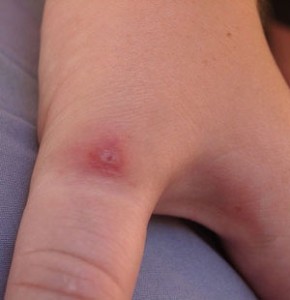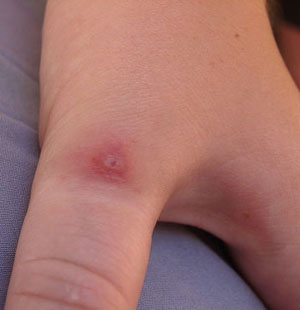
Most spiders are venomous. However, most venomous spiders lack an effective delivery system such as long fangs and powerful jaws unlike poisonous snakes and rarely do their bites penetrate the human skin. In places like North America, death rarely occurs from a spider bite and only bites from the Black Widow spiders can cause death if not treated promptly.
A spider bite is very difficult to diagnose, most specially when the spider was not seen or recovered from the scene. Since the bite generally don’t cause immediate and immense pain, victims rarely take precautions and delay medical care until such time the symptoms tend to aggravate and become very serious.
[note color=”#369bcc”]Recognizing a Black Widow Spider Bite [/note]
Call for first aid service providers immediately when you have a patient bitten by a poisonous spider. Black widow spiders have round abdomens with colors that vary from gray to black depending on the type and species. The female black widow spider has a shiny black abdomen with yellow or red spots which can be characterized by a shape of an hour glass. Signs of a black widow spider bite can include the following:
- The victim may feel a sharp pinprick when the spider bites, but most victims rarely become unaware of the bite. Normally, within 15 minutes a dull numbing pain develops in the area of the bite.
- Two small fang marks can be seen as tiny red spots.
- Victim experiences headaches, fever, heavy sweating, chills, dizziness, nausea and vomiting minutes and hours after the bite.
- Severe abdominal pain develops (if bite occurs on the arms, it can cause severe chest pain similar to a heart attack).
[note color=”#369bcc”]Recognizing a Brown Recluse Spider Bite[/note]
Brown recluse spiders are very prevalent in North America and are also called violin spiders or fiddle-back spiders. They have a violin shape figure on their backs hence the name violin spider was derived. However, several other spider species have very similar configuration on their backs and their color widely varies from fawn to dark brown with darker legs than their bodies.
Brown recluse spiders are located primarily in the North America. This spider is known to be an aggressive house spider which causes majority of reported spider bites in the region. Signs of a brown recluse spider bite include the following:
- A local inflammation reaction normally occurs within hours ranging from mild to severe pain and itching.
- Other signs include headache, fever, nausea, vomiting and weakness.
- A blister develops after several days which becomes red and will eventually burst. During the early stages of the reaction, the affected area will most likely take on a bull’s-eye appearance with a central area surrounded by a reddened area surrounded by a bluish white border.
- A scab will take form and will fall off in a few days but will leave a large ulceration of the skin. If left untreated, the ulcer will lead to slow tissue necrosis which can continue for weeks and months. Normally, severely damaged skin tissue requires extensive skin grafting.
[note color=”#369bcc”]Recognizing a Tarantula Spider Bite[/note]
Tarantulas rarely bite humans unless provoked or roughly handled by exotic pet owners. The bite varies from almost painless sensation to a deep throbbing and pulsating pain that lasts up to several minutes to an hour. Tarantulas normally don’t pack a lethal dose of venom and pain from the bite will subside with proper first aid care. Learn about CPR re-certification from us.
Related video: First Aid Treatments on How to Treat a Spider Bite
[media url=”http://www.youtube.com/watch?v=AagqVg3URBM” width=”600″ height=”400″][note color=”#369bcc”]Care for All Spider Bites[/note]
To care for any spider bite:
- If possible, catch and identify the spider.
- Wash the bitten area with soap and running water.
- Apply ice or cold pack over the bite area to alleviate pain and swelling.
- Seek medical care. For black widow spider bites, antivenin must be given as soon as possible to relieve pain and swelling. Call for emergency medical services especially of victims from a spider bite is a child, frail or elderly adult since this age group are at risk for severe complications and even death.
[note color=”#369bcc”]First Aid Services Reference for First Aid Care for Spider Bites[/note]
Alton, T. et al (2012). First Aid, CPR and AED Standard 6th Ed. Jones & Bartlett Learning


Hello
I have tons of bites from what I believe
Are spider bites or bed bugs or tick bites
And they are bad
What do I do
How will I know